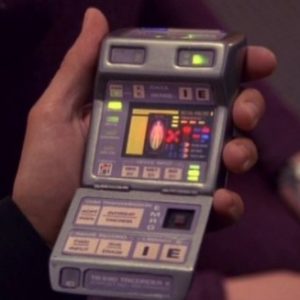In the 20th century, an American dream was for your child to become a medical doctor. A 18th-century British parent might similarly have dreamed of a child becoming a weaver.
When a team wins the Qualcomm Tricorder XPrize in 2017, prudent doctors might want to explore the parallel between medicine now and weaving then. The Tricorder prize turns science fiction to engineering and helps alter what it means to be a doctor, patient or researcher.
A half century ago, medicine wasn’t the highest-paid or most prestigious profession. Top athletes, artists, actors and executives earned much more than doctors, but in those professions the likelihood of reaching the top was vanishingly small and incomes could easily crash when winds shifted. A medical career, in contrast, was attainable for hundreds of thousands. Once a medical degree and professional license were in hand, the doctor could confidently plan on steady and ample income for life.
Not everyone could enter medicine. Prospective doctors had to clear high hurdles to enter the profession. They needed advanced cognitive skills and massive accumulated knowledge. These skills and knowledge weren’t transferrable to others, and generally couldn’t be automated.
Weavers in the 18th century shared these qualities with 20th-century doctors — until they didn’t.
After 1800, the weaver’s world changed just as the world is beginning to change for doctors and other cognitive professionals today. The Jacquard process (1804) took the knowledge once locked in weavers’ brains and transferred it to punch cards that drove power looms. (Decades later, Hollerith/IBM punch cards evolved to drive computing.)
Some weavers (the Luddites) responded to their altered circumstances by smashing looms (or contemplating doing so), but automation prevailed. Ultimately, traditional weavers lost their privileged economic position and security. New professions arose to service the industry. Textiles became more affordable and quality improved across multiple dimensions. For consumers and producers, traditional hand-woven goods became esteemed niche products.
Thanks to converging digital technologies, the weavers’ history is repeating in medicine. The Qualcomm Tricorder XPrize represents an example. The Tricorder prize website described the race as a “$10 million global competition to stimulate innovation and integration of precision diagnostic technologies, helping consumers make their own reliable health diagnoses anywhere, anytime.” (Other XPrizes focus on water scarcity, space exploration, literacy, computing, oceanography, etc.)
From the XPrize website: $6 million will go to the first team to develop a “device that will accurately diagnose 13 health conditions (12 diseases and the absence of conditions) and capture five real-time health vital signs, independent of a health care worker or facility, and in a way that provides a compelling consumer experience.”
Conditions must include “Anemia, Atrial Fibrillation (AFib), Chronic Obstructive Pulmonary Disease (COPD), Diabetes, Leukocytosis, Pneumonia, Otitis Media, Sleep Apnea, Urinary Tract Infection.” Teams may choose three others from: “Cholesterol Screen, Food-borne Illness, HIV Screen, Hypertension, Hypothyroidism/Hyperthyroidism, Melanoma, Mononucleosis, Pertussis (Whooping Cough), Shingles, Strep Throat.” The device must measure “Blood Pressure, Heart Rate, Oxygen Saturation, Respiratory Rate, Temperature.”
All must fit into a device weighing no more than five pounds. Diagnoses must be at least 70 percent accurate.
As Tricorder-like devices come on-stream, patients will be able to answer numerous questions that formerly required a doctor — and they’ll be able to ask these questions continually rather than episodically. Some doctors will find such technologies threatening. Others will see them as liberating — shifting their work from rote tasks to higher-level tasks. Echoes of bygone weavers.
The Tricorder competition itself reflects democratization of health care research. A total of 312 teams registered for the competition, 29 reached the next stage, and two (Dynamical Biomarkers Group and Final Frontier Medical Devices) now survive. The U.S. government recently established similar prizes — the Eureka Prizes — as part of the 21st Century Cures Act. One of the first such prizes was Britain’s Longitude Prize of 1714, which sought a revolutionary navigational tool around the time weaving began to automate.
The name “Tricorder” was borrowed from “Star Trek,” where a powerful diagnostic device was wielded by Dr. Leonard McCoy, whose emphatic catchphrase was, “I’m a doctor, Jim.” Depending on the tone of voice, McCoy’s phrase could convey confidence, condescension, calmness, helplessness or exasperation — sentiments doctors will feel as they seek their place in a digital world.


